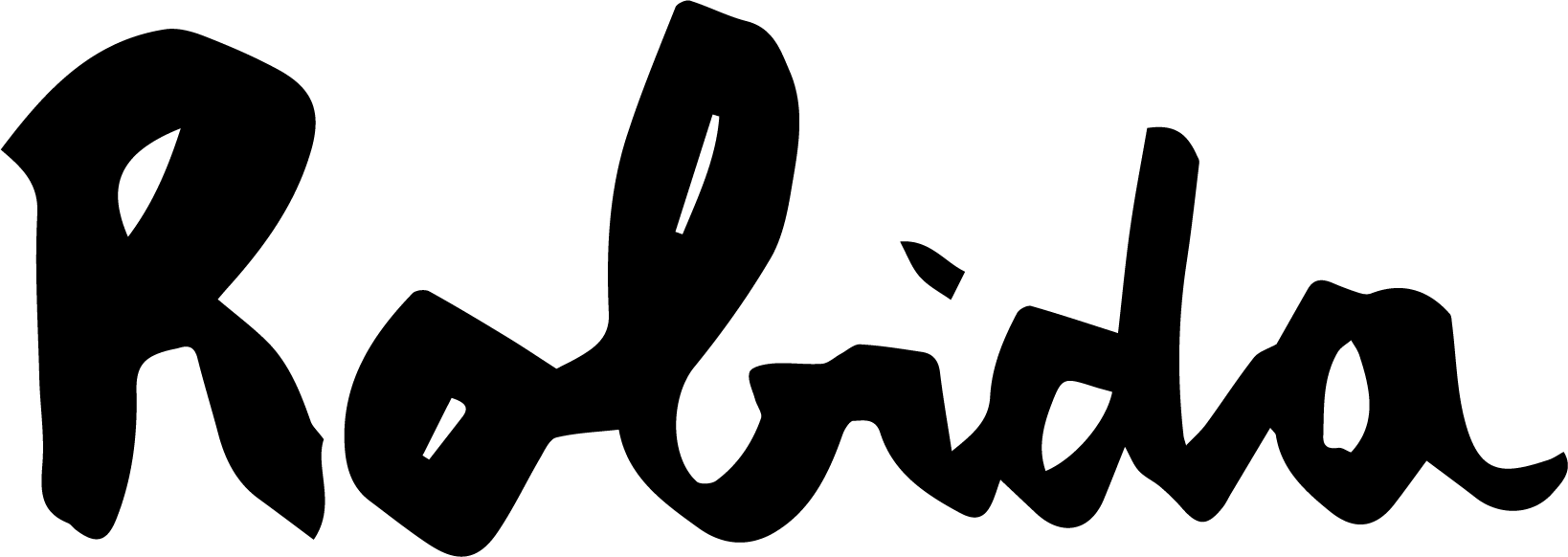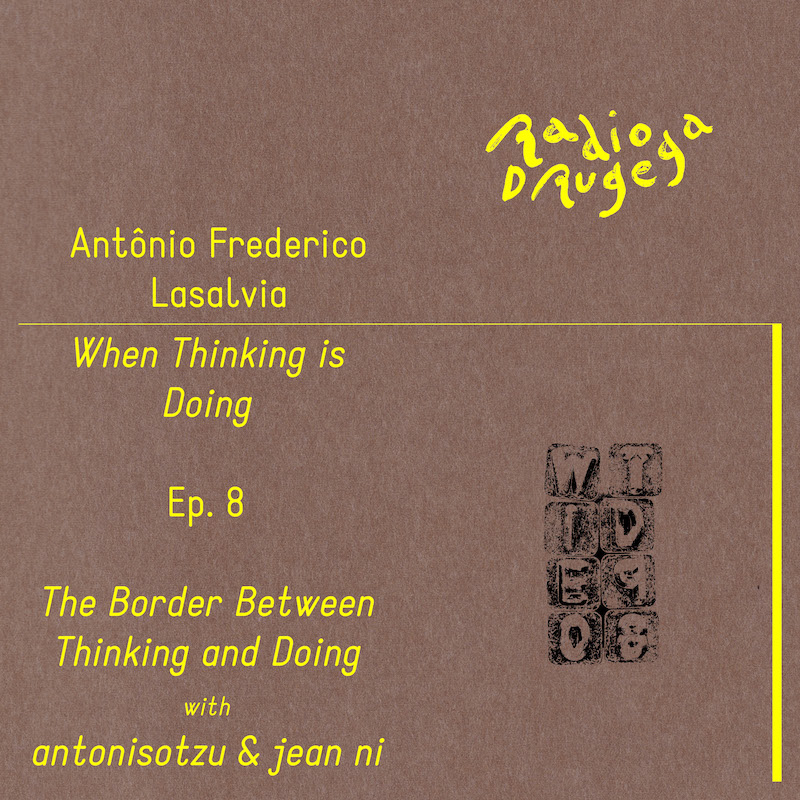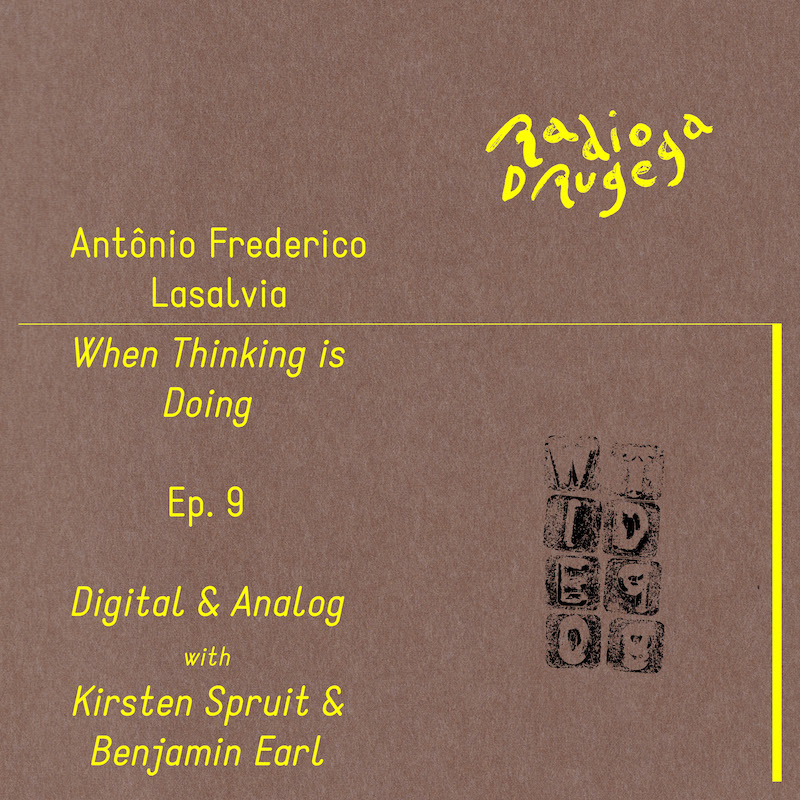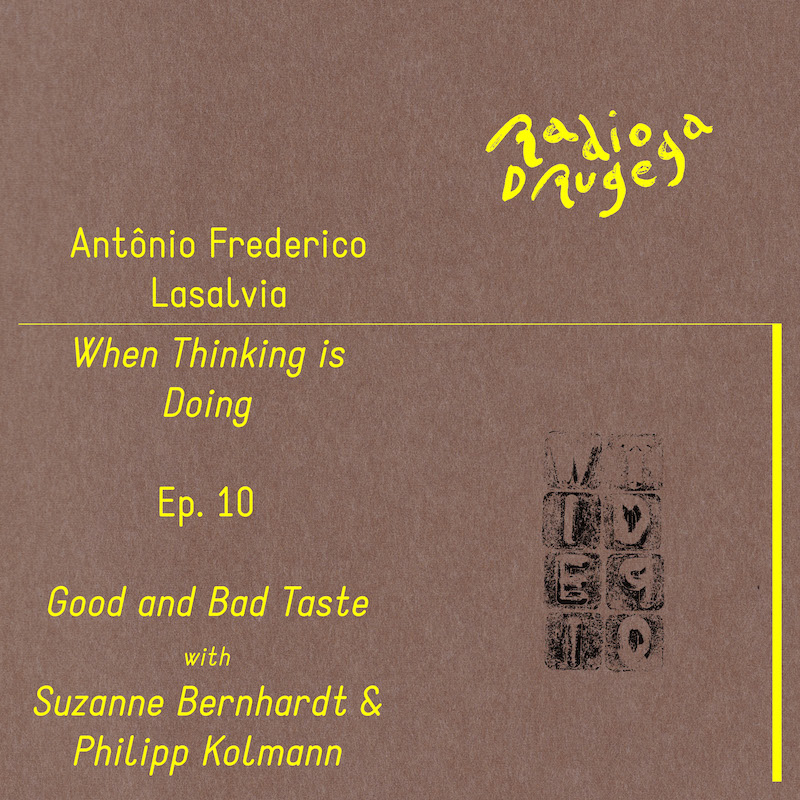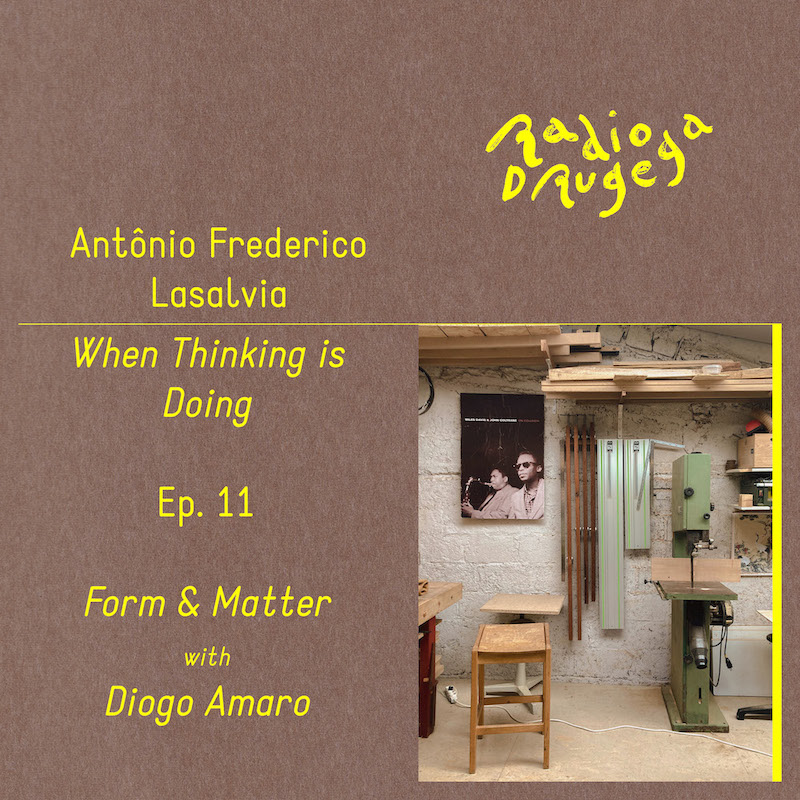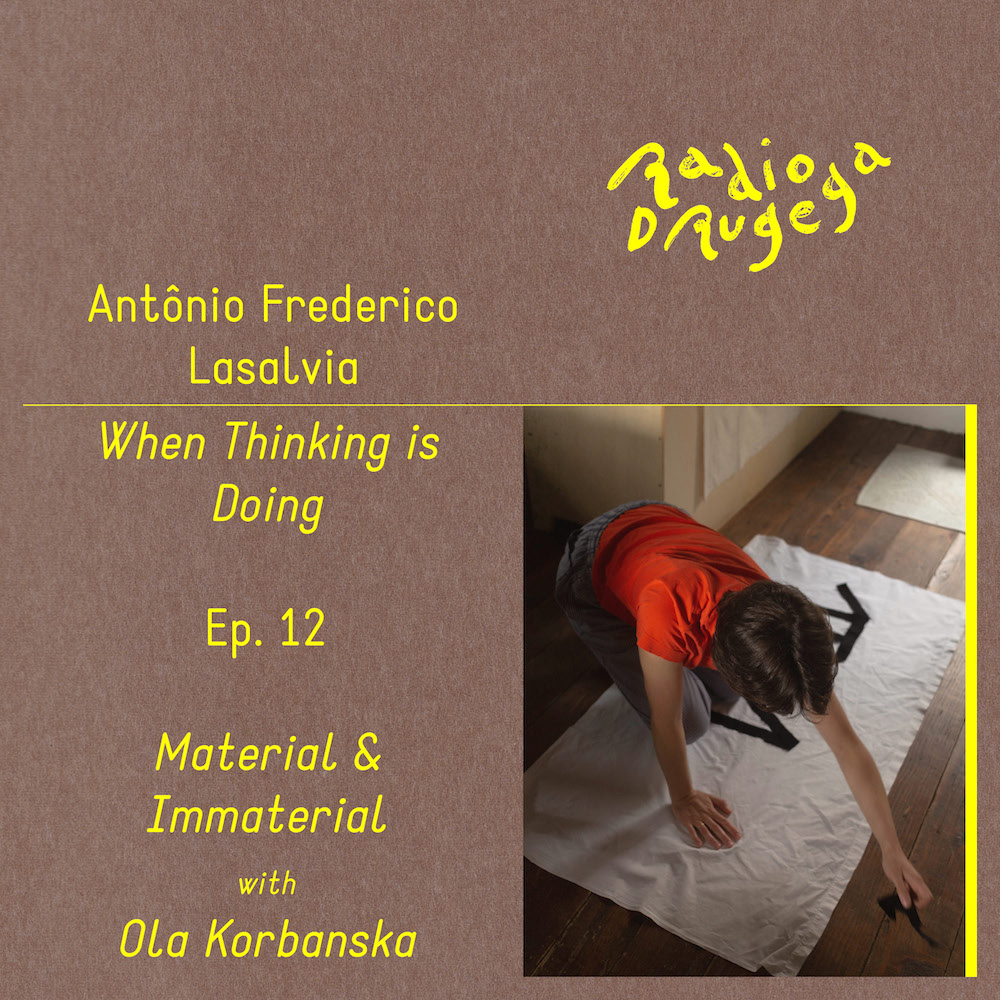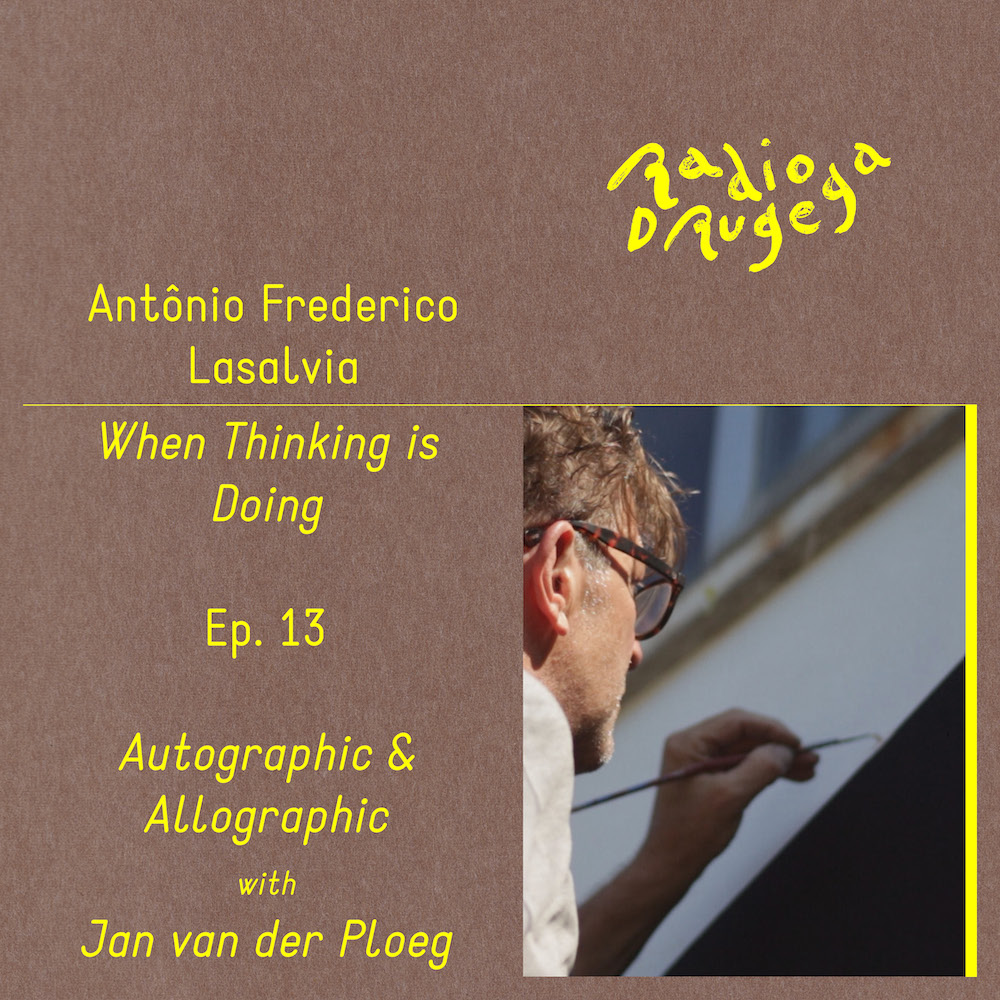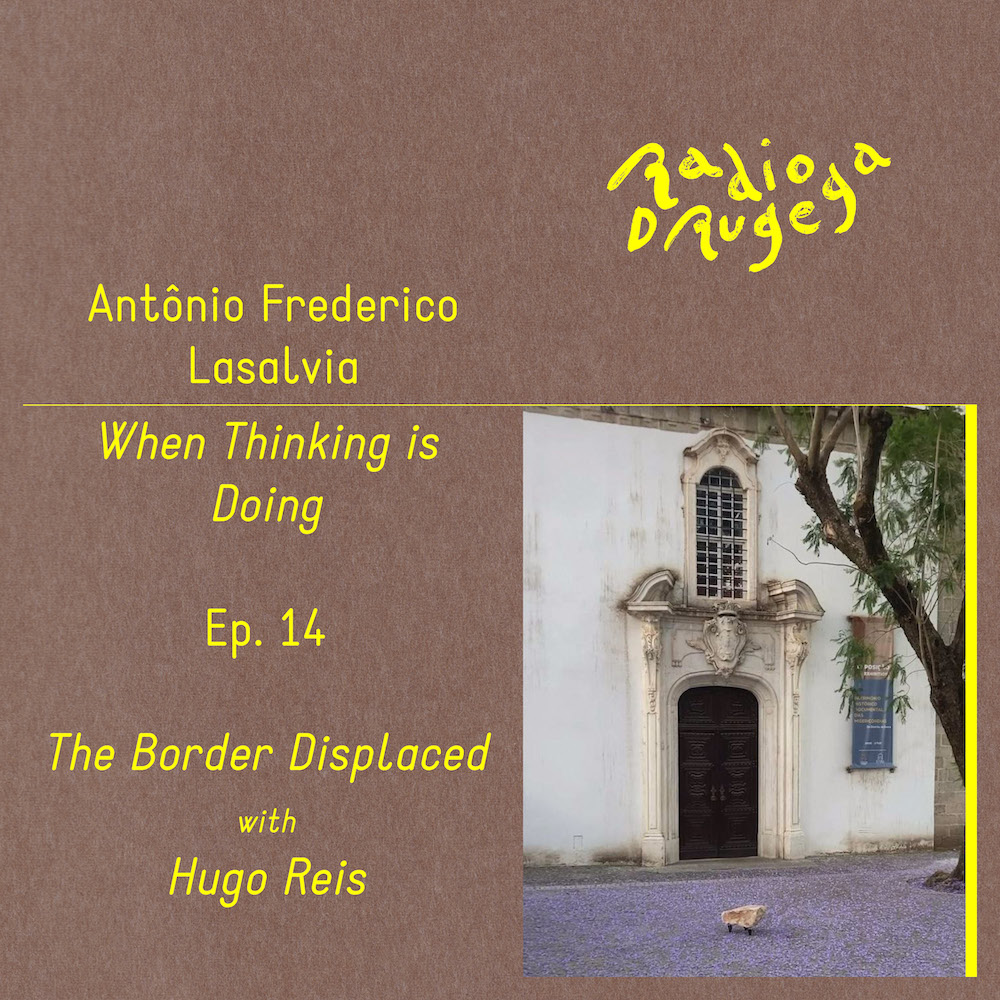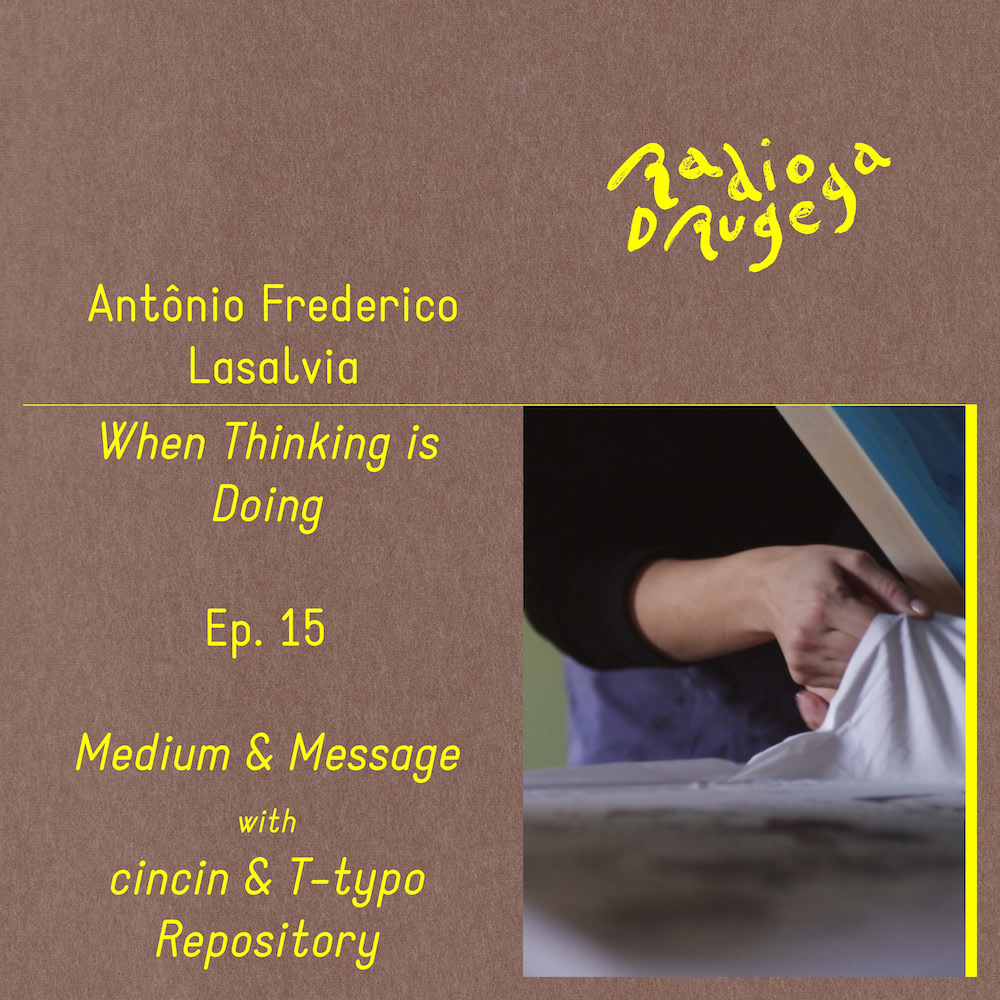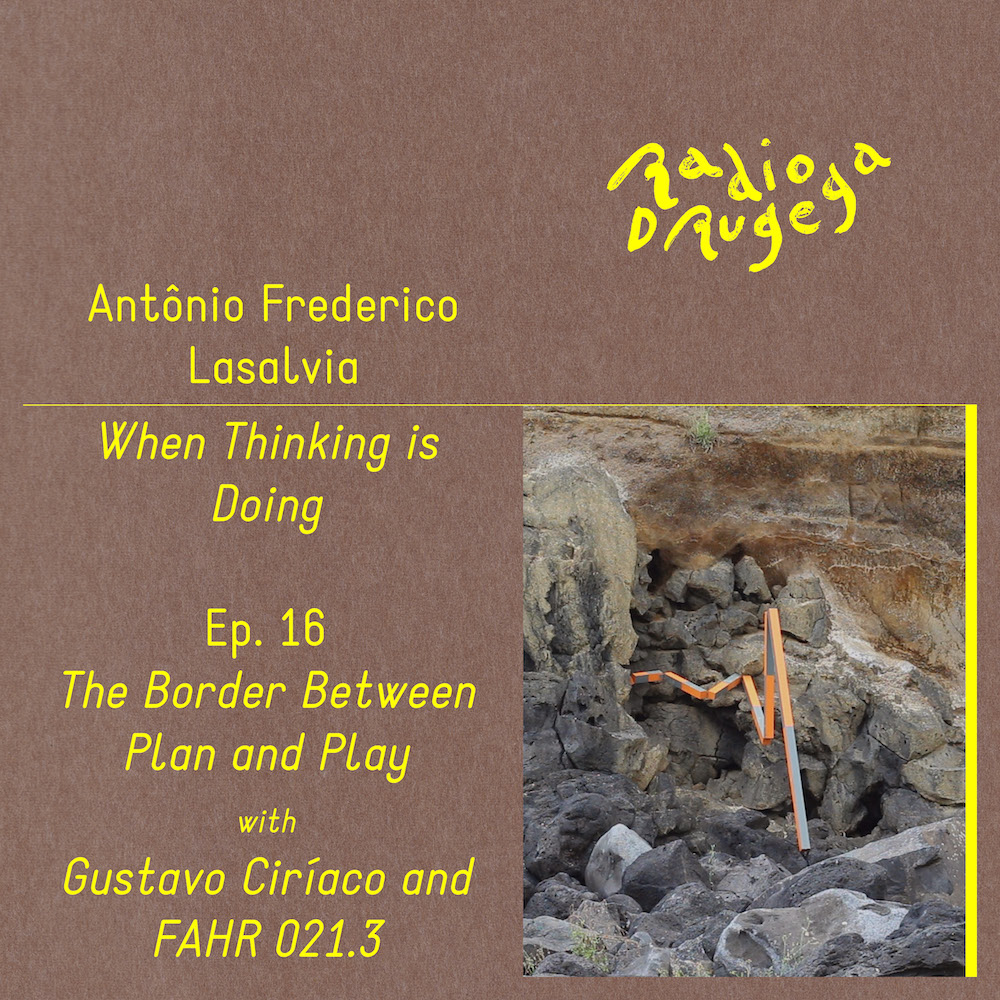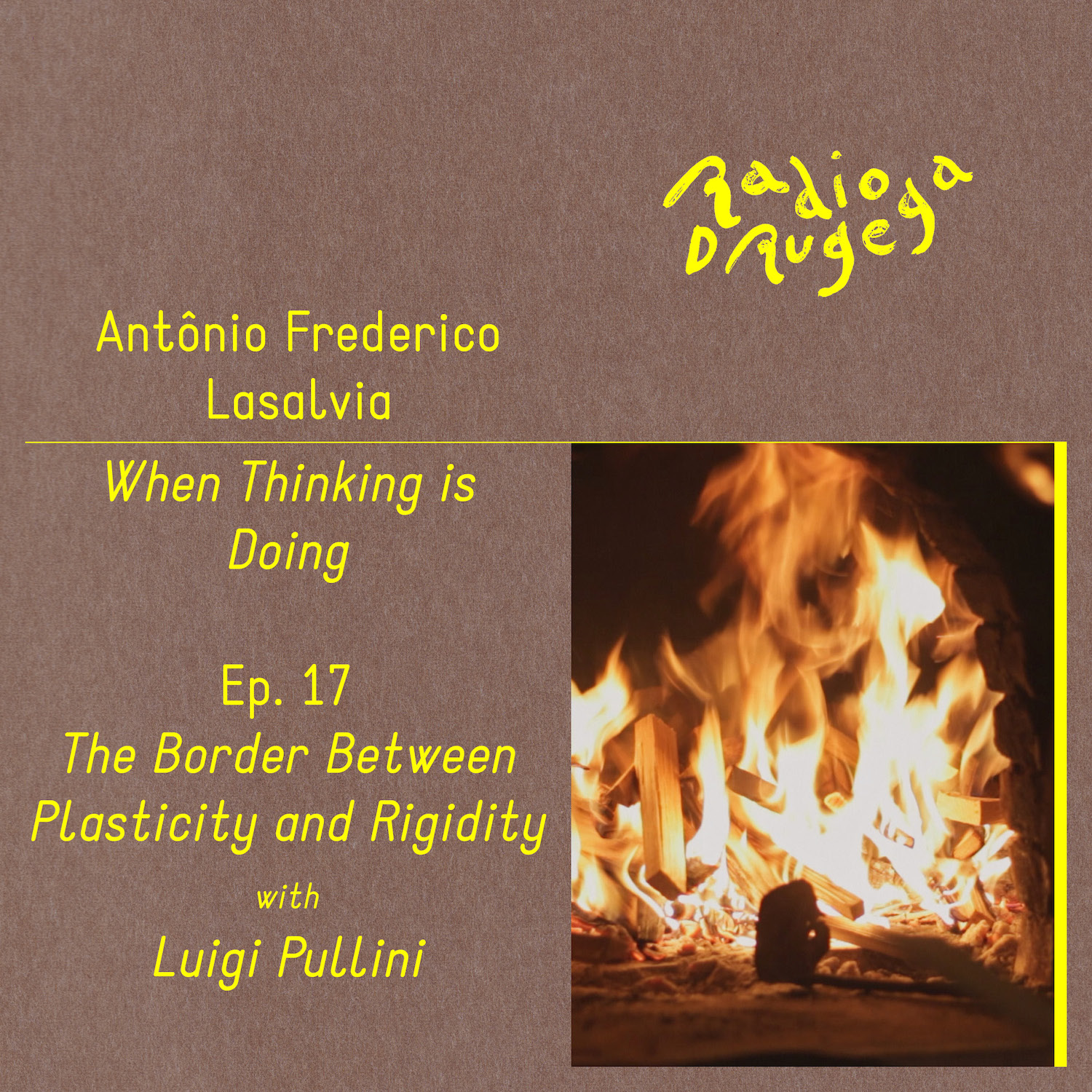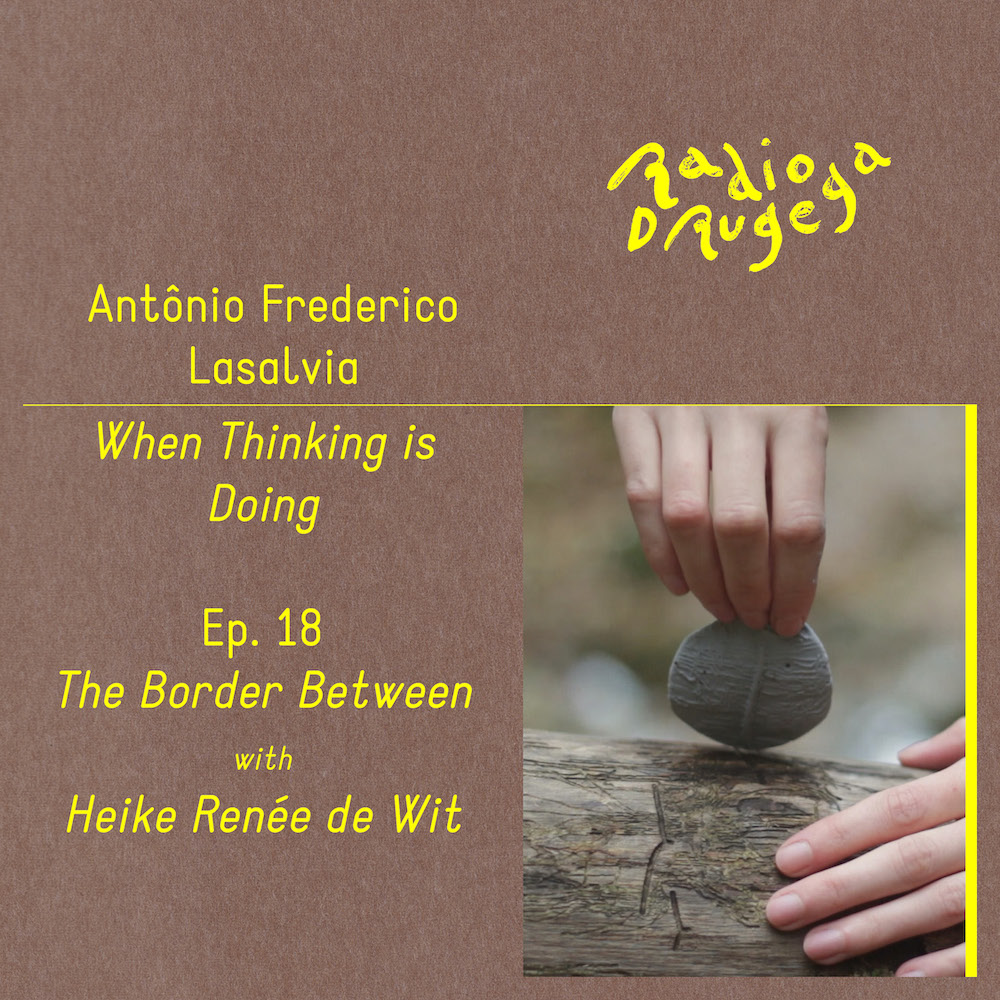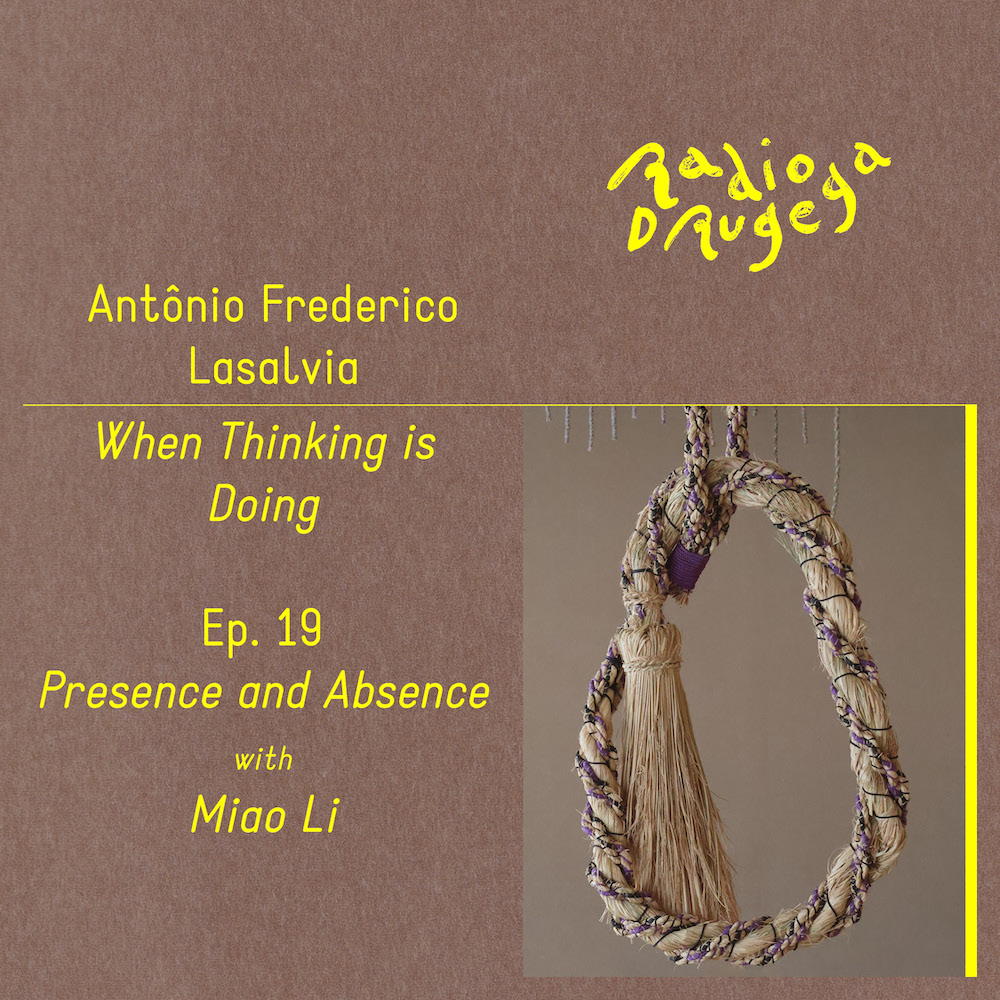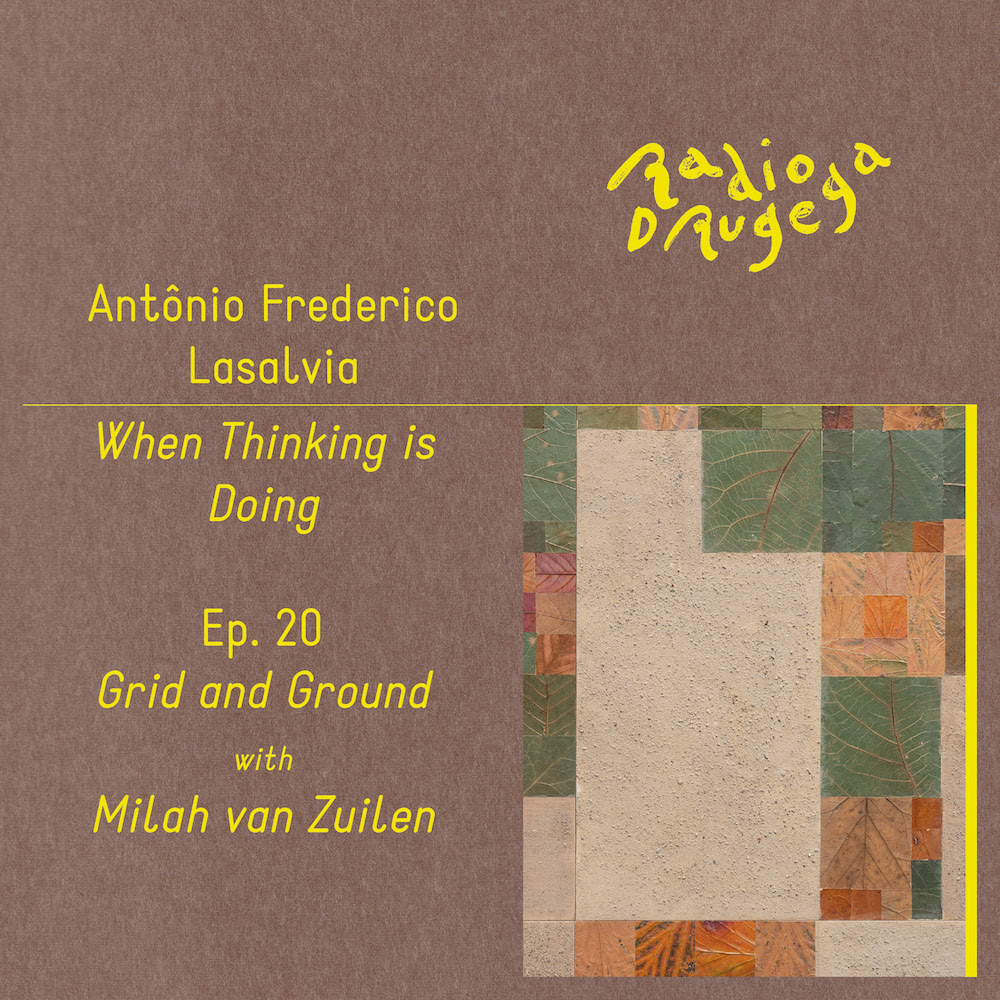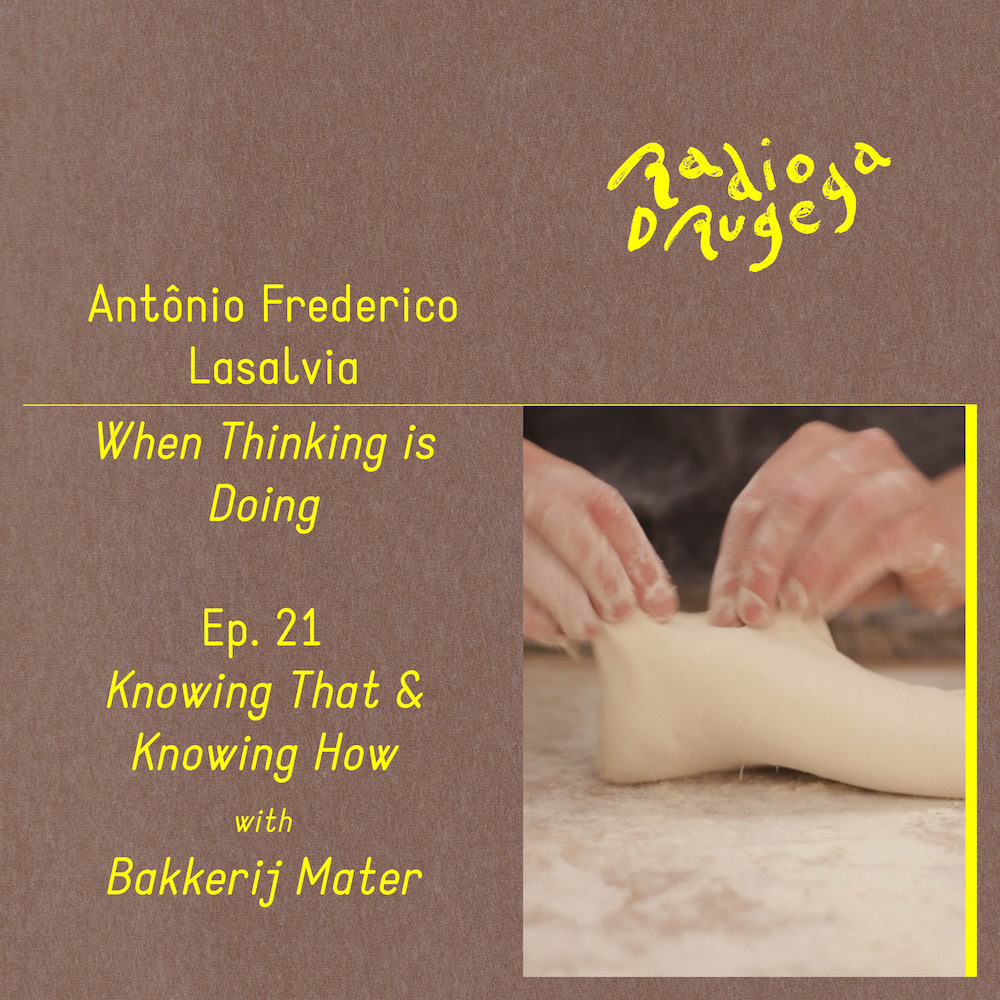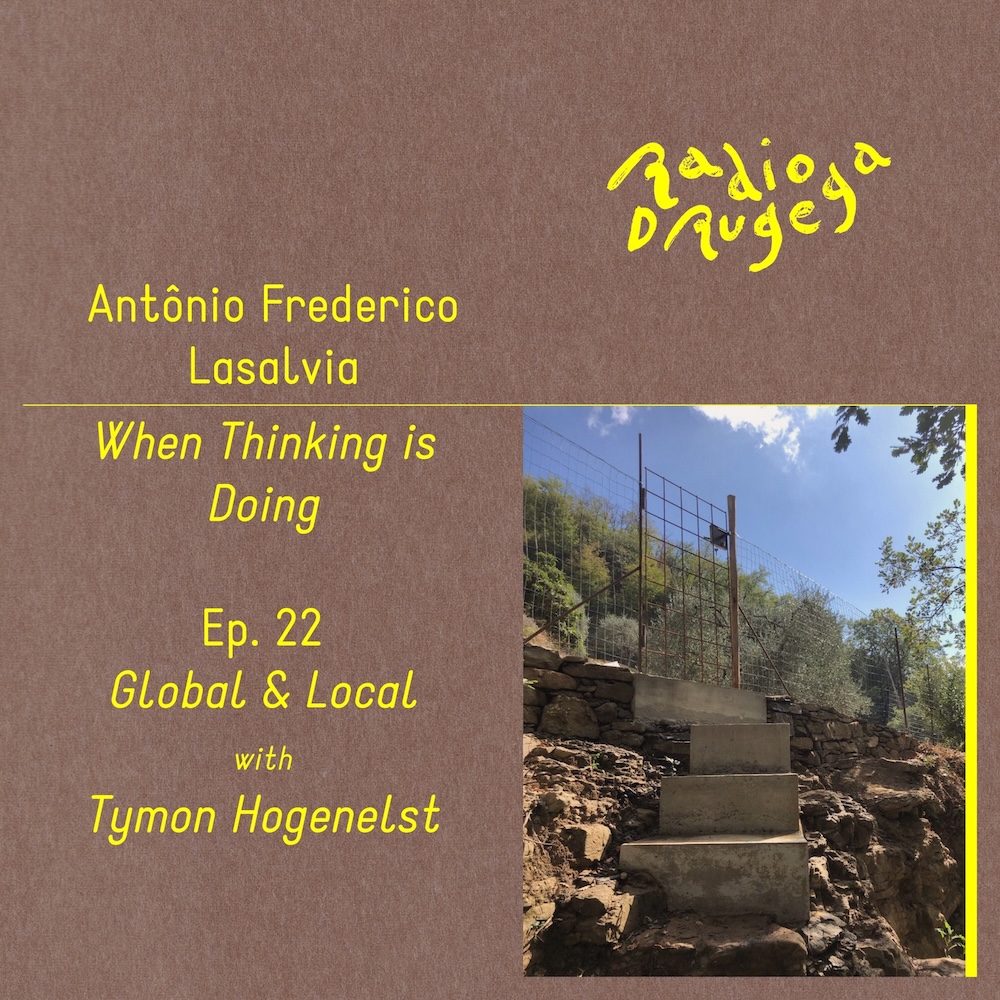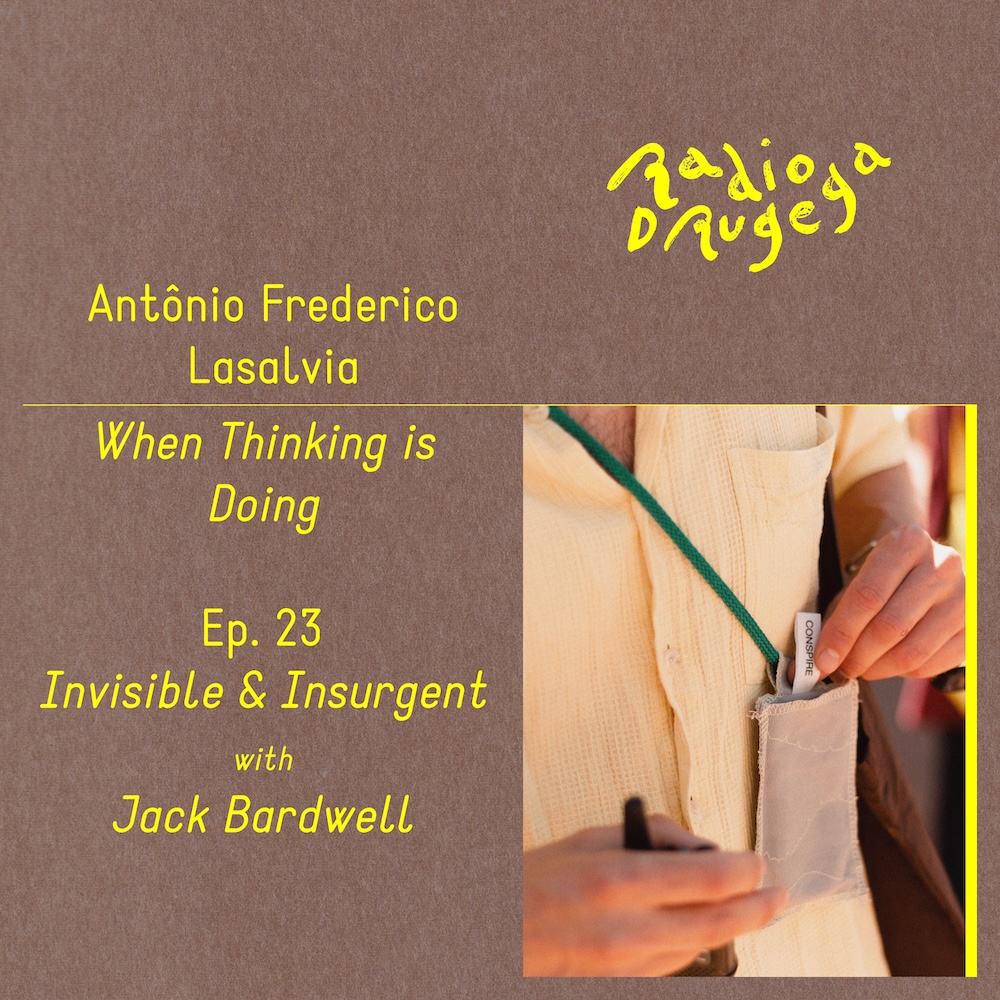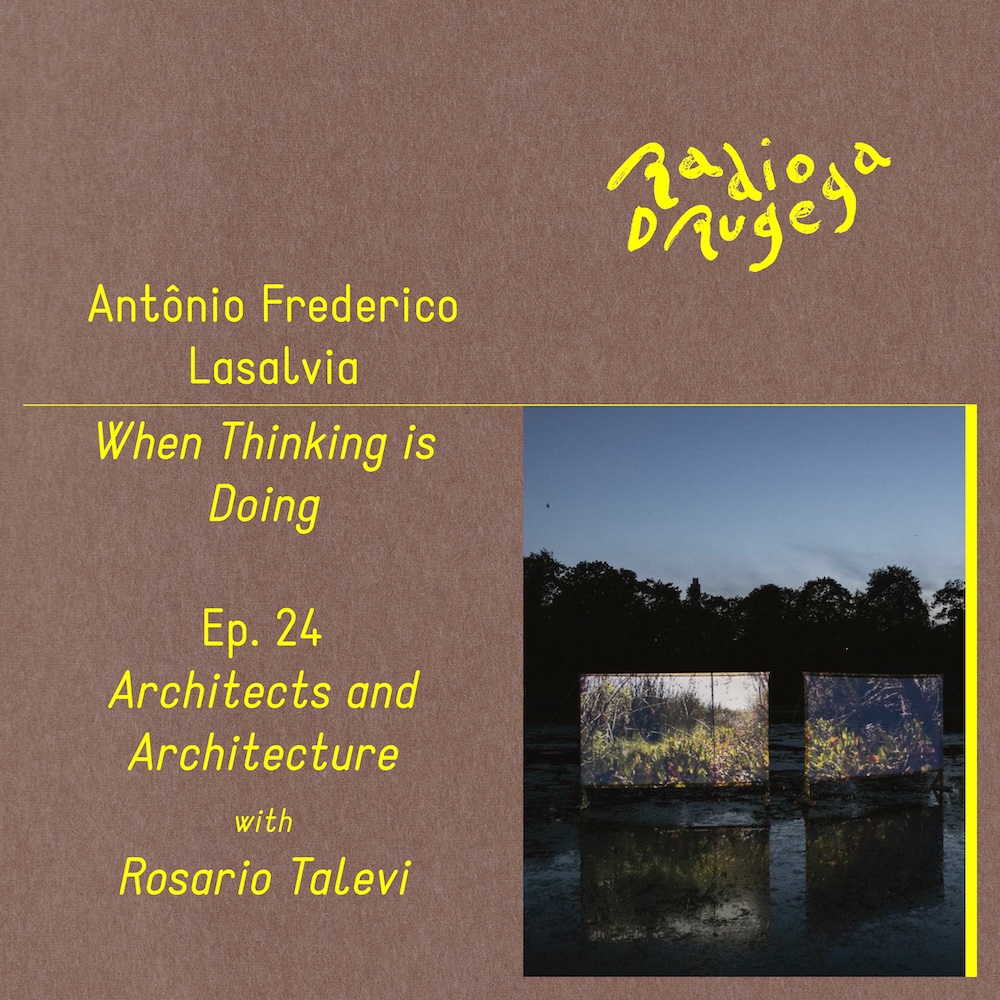The world is a whole. From a materialist perspective, between dense solids and rarefied plasmas, the discontinuities of tangible matter are always a question of scale and never actual interruptions on the fabric of reality. And yet, not only do we perceive, but we also enforce borders.
A border separates. It stipulates a distinction between elements. It creates opposites out of what is. What are the consequences of this segmenting action for the ways in which we conceptualize the world? Is there something advantageous to approach intellectual impasses by establishing simple antinomies among things? Could it be dangerous to polarize? How and why?
In the second season of When Thinking is Doing, we will indulge in bordering thought. In each episode, Antônio Frederico Lasalvia conceptualizes craft and its neighboring areas by creating clear categories around them - often, only to find out that these limits are porous and trespassers negotiate their confines just as we are not looking. Through the perspectives of different guests engaged with hand and head work, we will try to better understand not only the complexities of making, but of the making of the world.
The Other Radio/Radio Drugega program is financed by Javni zavod GO! 2025 - Evropska prestolnica kulture, Nova Gorica.
〰️
Svet je celota. Z materialističnega vidika so med gostimi trdnimi snovmi in redko plazmo diskontinuitete oprijemljive snovi vedno vprašanje obsega in nikoli dejanske prekinitve v strukturi realnosti. Pa vendar mej ne le zaznavamo, ampak jih tudi ustvarjamo.
Meja ločuje. Določa razlikovanje med elementi. Ustvarja nasprotja iz tega, kar je. Kakšne so posledice tega segmentiranja za načine, na katere konceptualiziramo svet? Ali obstaja kaj koristnega za pristop k intelektualnim slepim ulicam z vzpostavljanjem preprostih antinomij med stvarmi? Je lahko polarizacija nevarna? Kako in zakaj?
V drugi sezoni oddaje When Thinking is Doing se bomo prepustili mejni misli. V vsaki epizodi bo Antônio Frederico Lasalvia konceptualiziral obrt in sosednja področja z ustvarjanjem jasnih kategorij okoli njih – pogosto samo zato, da bo ugotovil, da so te meje porozne in da se prestopniki pogajajo o svojih mejah ravno takrat, ko jih ne opazujemo. Skozi perspektive različnih gostov, ki se ukvarjajo z ročnimi in miselnimi deli, bomo skušali bolje razumeti ne le kompleksnost ustvarjanja, ampak tudi ustvarjanja sveta.
Program Radia Drugega/The Other Radio financira javni zavod GO! 2025 - Evropska prestolnica kulture, Nova Gorica.
〰️
Ep. 24 The Border Between Architects & Architecture, w/Rosario Talevi
How can feminist ethics, collaborative resourcefulness and attention to invisibilized labor help reframe our understanding of space and everything that surrounds it? What happens when architects expand their roles beyond design itself—engaging with the afterlife of buildings, the infrastructures that sustain them and the social relations they enable?
In the 24th episode of When Thinking Is Doing, Antônio Frederico Lasalvia speaks with Rosario Talevi, about the porous boundaries between architecture, pedagogy and the politics of relations. From her involvement in Berlin’s Floating University and the festival Climate Care to her collaboration with the collective Soft Agency, we reflect on practices that expand architecture beyond building.
Bibliography:
- Elke Krasny. Architecture and Care. (2019)
- Mierle Laderman Ukeles. Maintenance art manifesto. (1969)
Ep. 23 The Border Invisible and Insurgent, w/Jack Bardwell
What kind of spaces can be created by invisible things, like electromagnetic frequencies and sound waves? And what sort of physical and social manifestations can mediums such as radio and internet radio support? In the 23rd episode of When Thinking is Doing, Antônio Frederico Lasalvia is joined by Jack Bardwal in order to think through sonic and spatial practices.
The conversation touches on how radiophonic experience can help unleash collective imagination, activate focused attention and promote a renewed sense of agency towards everyday environments. We also discuss historical predecessors to “the wireless”—which worked as long-distance communications and generated temporary spaces for gathering before electricity—as well as reflect about the possible futures of obsolete technologies.
Bibliography:
- Marshall McLuhan. Understanding Media: The Extensions of Man. (1964)
- Kate Donovan. Radio as Relation. Listening across worlds of artistic research, technologies and the more-than-human. (2025).
Ep. 22 The Border Between Global and Local, w/Tymon Hogenelst
How can we learn from the invisible and the invisibilized knowledge of a place?In the twenty-second episode of When Thinking is Doing, Antônio Frederico Lasalvia is joined by Tymon Hogenelst in order to discuss situated architecture.
The conversation touches on the avant-gardist position of gardeners, how architecture can be practiced in a situated manner and the way in which dry-stone walls can be read as an archive of technique that promotes a conversations dilated across time. We explore landscapes as sites of theory-in-practice and describe the joys and frustrations of learning by doing. As we reflect on the kinds of intelligence required to enter into dialogue with a place, we acknowledge the lively exchange that can exist between the global and the local.
Bibliography:
- Adolf Loos. Architecture (1910)
- Kenneth Frampton. Towards a Critical Regionalism: Six Points for an Architecture of Resistance (1983)
Ep. 21 The Border Between Knowing That and Knowing How, w/Bakkerij Mater
What is the difference between knowing something in theory and knowing it with your own body? And why does our culture still tend to value one more than the other? In this episode, we follow a story that brings to light the kinds of understanding that cannot be easily abstracted or codified: ways of knowing that are directly derived from practice. What if these forms of knowledge are precisely what we need in order to navigate the intertwined crises of food, health and ecology today?
For the 21st episode of When Thinking is Doing, Antônio Frederico Lasalvia visits Bakkerij Mater, a sourdough bakery in Amsterdam run by the van Aalst family: Sascha, Philip, Nick, and Willem. What began as an improvised experiment with homemade bread slowly became a space for communal gathering, embodied politics and ecological transition. As we talk about natural fermentation, networks of production, croissants and the daily rhythms of dough, we also uncover personal stories of departure and arrival. With different backgrounds ranging from corporate finance to yoga teaching and academic philosophy, they now work together in a place where knowing how is not less than knowing that.
Bibliography:
- Gilbert Ryle. Knowing How and Knowing That. (1945–1946).
- James C. Scott. Seeing Like a State: How Certain Schemes to Improve the Human Condition Have Failed. (1998)
Ep. 20 The Border Between Grid and Ground, w/Milah van Zuilen
How can an artwork remain open to its environment while still offering a critical stance toward contemporary paradoxes? And what kind of artistic roles emerge from the tension between natural spontaneity and artificial order – especially after the experiences of romanticism, conceptualism, land art, and the ecological turn in artistic discourse?
In the 20th episode of When Thinking is Doing, Antônio Frederico Lasalvia is joined by Milah van Zuilen in order to discuss her practice between forest ecology and art. Our conversation touches on the materiality of contemporary and primordial forms, the intersection between the methodologies of art and science, the use of the grid to make sense of nature, the role of artistic residencies in promoting social relations and her experience as a host in Jaro, in the Czech Republic.
Bibliography:
- Lucy Lippard. Overlay: Contemporary Art and the Art of Prehistory. (1983)
Ep. 19 The Border Between Presence and Absence, w/Miao Li
How does one’s engagement to material processes shape the way the world is perceived? Can gestures repeated across time and space carry meaning beyond their original function? And what is the role of design and designer when one chooses to follow the intelligence of materials?
In the nineteenth episode of When Thinking is Doing, Antonio Frederico Lasalvia is joined by Miao Li in order to think about ways of attending to matter. As we accompany Miao’s workshop practice, our conversation touches on experiences with fiber art and ceramics that employ both traditional and experimental techniques. Guided by animist philosophies and Buddhist meditation, Miao’s understanding of beauty offers a quiet, but radical reimagining of contemporary aesthetics, rooted in attention and intuition for the slow unfolding of form.
The ambient sounds of Miao’s workshop were recorded in Arnhem, by Heike Renée de Wit.
Image on the cover courtesy of Miao Li.
Ep. 18 The Border Between, w/Heike Renée de Wit
How does graphic design relate to the sense of time passing and time arrested? Between absence and presence, permanence and decay, how can art help us remain alert to what is already there?
In the 18th episode of When Thinking is Doing, recorded during the Sensing Soils residency in Tópolò, Antonio Frederico Lasalvia is joined by Heike Reneé de Wit in order to speak about the border between – between forest and village, solitude and collectivity, visibility and invisibility. Through different ways of approaching the landscape, Heike explores gestures that generate spatial experiences that are ephemeral, playful, and deeply embodied. What emerges is a form of silent language, coded through anatomy, scale, and ground, that reflects on the afterlife of materials and the (super)natural composition of forms.
Bibliography:
- Rosalind Krauss. Passages in Modern Sculpture. (1977)
- Ismael Abderrahim Arribas. Sobre Puertas Y Umbrales. Un Diseño Editorial Entre Imágenes Y Textos. (2023)
Ep. 17 The Border Between Plasticity and Rigidity, w/Luigi Pullini
What is the relation between spontaneity and permanence? In the seventeenth episode of When Thinking is Doing, Antônio Frederico Lasalvia is joined by Luigi Pullini in order to speak about working with clay.
Our conversation was held after Luigi mas in Topolò in the winter of 2024 for the Sensing Soils residency. As we discuss the work he developed around foraged local clay, we think through notions like purity and impurity, the value of labour and materials, and the empirical transmission of knowledge across space and time.
Bibliography:
- Octavio Paz and World Crafts Council. In Praise of Hands. (1974)
- Yanagi Sōetsu. The Unknown Craftsman. (1972)
Ep. 16 Plan & Play, w/Gustavo Ciríaco and FAHR 021.3
How do objects choreograph the gestures around them? In the sixteenth episode of When Thinking is Doing, Antônio Frederico Lasalvia is joined by Gustavo Ciríaco, together with Filipa Frois Almeida and Hugo Reis from FAHR 021.3, in order to reflect on plan and play.
This conversation was carried out after the development of the artistic residency “Cérebro/Brains,” which resulted in an intervention that draws from the spatial poetics of Portuguese sculptor Miguel Palma. As we discuss the methodology adopted by Círiaco in the series “Covered by Sky,” we reflect on how art may incorporate different forms of alterity by way of relationality: either through the dialogue with other authors’ discourse, through public engagement or through the activation of the landscape.
Bibliography:
- Lygia Clark. Os Bichos. (1960).
- Paola Berenstein Jacques. Estética da Ginga. (2001).
Ep. 15 Medium & Message, w/Cincin & T-typo Repository
In the fifteenth episode of When Thinking is Doing, Antônio Frederico Lasalvia is joined by Francesca Lucchitta and Elena Braida from Cincin and Alice Alloggio from T-typo Repository in order to speak about their collaboration for the Towel Calendar 2025.
Franca, Elena and Alice were in Topolò last November in order to make some silkscreen prints and I took the chance to speak to them about their serigraphy work. Our conversation touches on themes like the reignification of used garments, the unattainable history behind materials and the purposeful manipulation of ready-made messages.
@cincincincincincincincincin
@ttypo_repository
The video of their experience in Topolò can be found here!
Ep. 14 The Border Disclosed, w/ Hugo Reis
The immobility of stone makes it a suitable medium for enforcing sculpture’s traditional role as a spatial disciplinary dispositive, as, in the words of Rosalind Krauss, “it sits in a particular place and speaks in a symbolical tongue about the meaning or use of that place.” But what if the materiality of marble was used otherwise, as an artifice to question sedimented conventions about public space?
In the fourteenth episode of When Thinking is Doing, Antônio Frederico Lasalvia is joined by Hugo Reis in order to think about the act of demarcating borders. As we follow his artistic/research practice by transporting boulders around the city of Évora, we discuss the relation between art and urbanism and reflect about sculpture in the expanded field.
Bibliography:
- Rosalind Krauss. Sculpture in the Expanded Field. (1979)
- Charles Jencks, Nathan Silver. Adhocism: the Case for Improvisation. (1972)
Ep. 13 The Border Between Autographic and Allographic, w/ Jan van der Ploeg
When Jan van der Ploeg was in Topolò last August, I followed him through the restoration of two wall paintings he made a few years ago. As one of the murals metamorphosed into the third version of itself, while the other kept its former colors and composition, it left me wondering about the who and the how of art.
In the thirteenth episode of When Thinking is Doing, Antônio Frederico Lasalvia speaks to Jan van der Ploeg about his work as a painter. The conversation touches on themes like Jan’s relation to the village of Topolò through the years thanks to Stazione Topolò/Postaja Topolove, his early experiences in the shift of mediums from oil painting to mural painting and his phased approach towards his practice, based on the isolated stages of composition and execution.
Bibliography:
- Alexander Alberro & Blake Stimson. (Eds.). Conceptual Art: A Critical Anthology. (1999)
- Nelson Goodman. Languages of Art. (1976)
- John Roberts. The Intangibilities of Form: Skill and Deskilling in Art After the Readymade. (2007)
Ep. 12 Material & Immaterial, w/ Ola Korbańska
Art matters. Or, at least, art is made out of matter. Or is it? In the aftermath of the readymade and the so-called dematerialization of the art object - when an abstracted ideal of artistic conception was praised over the material execution of artworks - how may the practice of making things be reclaimed as a valuable form of labour in art today?
In the twelfth episode of When Thinking is Doing, Antônio Frederico Lasalvia is joined by Ola Korbańska in order to think about the border between material and immaterial. As we follow the sewing of an iteration of “THE FLAG OF 3,” our conversation touches on themes like: the materiality of words and the longest way of writing things, the incorporation of gender struggles into artistic discourse; the adoption of constraints as a creative methodology; the phased development of technique over time; the joy of making things; and the purposeful contamination of artworks by their contextual conditions of production.
Bibliography:
- Alexander Alberro & Blake Stimson. (Eds.). Conceptual Art: A Critical Anthology. (1999)
- John Roberts. The Intangibilities of Form: Skill and Deskilling in Art After the Readymade. (2007)
Ep. 11 Form & Matter, w/ Diogo Amaro
Between matter’s character and maker’s character, what might craft mean when one attends to the way in which raw materials express their forms?
In the eleventh episode of When Thinking is Doing, Antônio Frederico Lasalvia is joined by the architect and cabinetmaker Diogo Amaro in order to think about the border between form and matter. The conversation touches on themes like anticipation and spontaneity in work, the role of prototyping, the contrast between serial and singular production and the consequences of an empirical approach to design.
Bibliography:
- Michael Baxandall. The Limewood Sculptors of Renaissance Germany. Yale University Press. (1980)
- Kiyosi Seike. The Art of Japanese Joinery. Shambhala. (1977).
Ep. 10 Good and Bad Taste, w/ Suzanne Bernhardt & Philipp Kolmann
In the tenth episode of When Thinking is Doing, Antônio Frederico Lasalvia is joined by Suzanne Bernhardt and Phillip Kolman in order to think about the making of food. In the introduction, the culinary arts are considered in relation to other forms of aesthetically engaging with matter, such as painting or sculpture. Could it be that the different social standings that these practices historically reached is related to a phenomenology of sensory experience?
In the second part of the show, we go outside to pick wild-cherry flowers. While foraging in the forest, Phillip and Suzanne speak about how they see their cooking practice with regard to autochthonous food cultures, the role of the ephemerality in taste and the ecological consequences of alimentary production.
Bibliography:
- Carolyn Korsmeyer. Making sense of taste: Food and philosophy. (1999)
- Jane Bennet. Vibrant Matter: A political ecology of things. (2009)
Ep. 9 Digital & Analog, w/ Kirsten Spruit & Benjamin Earl
The term craft is usually reserved to qualify a way of making material things. How would this notion stand when transposed to the immaterial realm?
In the ninth episode of When Thinking is Doing, Antônio Frederico Lasalvia is joined by Kirsten Spruit and Benjamin Earl in order to think through the border between the digital and the analog. As we look for procedures analogous to craft within the virtual sphere, we consider themes like the poetic web, handmade websites, Ben and Kirsten’s “code of conduct of code”, as well as their growing interest in rituals of maintenance.
Bibliography:
- Glenn Adamson. The Invention of Craft. (2013)
- Bruno Latour. Pandora’s Hope. (1999)
Ep. 8 The Border Between Thinking and Doing, w/ antonisotzu & jean ni
The eighth episode of WTID comes in hybrid form. The first part (1:38) of the show is a theoretical introduction where we problematize the very notion of craft following art historian Glenn Adamson’s critique of craft’s origin in the wake of the industrial revolution. How can we deterritorialize craft and its congenital opposition to mechanized labour?
In the second part of the show (13:00), some of the questions raised in the introduction are tackled from the perspective of guests Antonio Sotzu and Jean Ni. In our conversation, matters of pleasure, knowledge and meaning in old-fashioned techniques are discussed in relation to their territorial approach to stone artifacts making/maintenance. We also discuss their life-project Foghiles, based in Semèstene, Sardinia, where borders between life and art are dissolved.
Bibliography:
- Stephen Epstein. Transferring Technical Knowledge and Innovating in Europe, c.1200-1800. (2005)
- Glenn Adamson. The Invention of Craft. (2013)
Ep. 7 Artigiainer, w/ Tommaso Garavini
In the seventh episode of When Thinking is Doing we have an interview with Porano-based artist and designer Tommaso Garavini. With an artisanal practice ranging from wood and metal to stone working, he develops unique pieces that are oriented not only by the properties of matter, but also by the shapes in which materials come in.
In our conversation, Tommaso speaks about his departure from painting into woodworking, which was driven by an ever-growing interest towards different kinds of craft. According to him, the challenges presented by the specificity of each medium work as a constant source of creativity behind the design process.
Ep. 6 Industry and Art(ifice), w/ FAHR 021.3
In the sixth episode of When Thinking is Doing, the Porto based studio FAHR 021.3 is interviewed by Antônio Frederico Lasalvia, motivated by a recent work realized on the verge between art and industry: the piece called Matriz 45.
The conversation touches on contemporary approaches to the relation between the creative act and the assembly line, as FAHR elaborates on what is there to be gained from a transdisciplinary overview. Hugo Reis and Filipa Frois Almeida talk about their creative process, the role of the author in contemporary and 20th century art, the importance of mistakes and how to frame them, and the constant quest for reinvention in their work.
Ep. 5 Post-Digital Craft, w/ Tomasz Symosz
In the fifth episode of When Thinking is Doing, Antônio Frederico Lasalvia is joined by Tomasz Symosz in order to discuss the intersection of manufacture and computer-aided design. Between standarization and irregularity, post-digital craft is speculated as a path to embrace material singularity.
The conversation is the result of a week-long residency on an upcoming project that intends to question some sedimented paradigms of design, such as the hylomorphic ideal. What is presented instead as a viable approach is a programmable process where the finished piece is not wholly predetermined, but exists virtually between a pre-established range of possibilities.
Ep. 4 OOO and the Carpentry of Things
In the fourth episode of When thinking is doing, we seek to depict craft through the metaphysics developed by philosopher Harman Graham in what is known as Object-Oriented Ontology. We follow how his phenomenological background expands into an original interpretation of withdrawn objects, and how this understanding of the autonomy of things can serve as a creative disposition for technique.
Shadowing the metamorphosis of artefacts, doing is taken to be a particular way of probing the structure of the world. In this perspective, artisanship is understood as building upon a specificity inherent to singular objects in order to disclose new objects. By means of this phased process, the resultant forms can only ever be created because they are derived from material characteristics that were brought forward and potentiated.
Ep. 3 A Matter of Flatness
In the third episode of When Thinking is Doing, the concept of flatness is approached from different angles. In the first part of the program, flat ontology is deployed in order to understand making focused on the positive properties of material that allow it to be shaped. Following Gilbert Simondon's thought, the haecceity of raw matter is taken up as a defining order that prescribes transformation processes.
In the second part of the show, flatness is considered from another point of view, through a history of art perspective. The ideas of Clement Greenberg are called upon in order to delineate where his conceptual program approximates and diverges from the ideas advanced in this show. With that, what is intended is to focus on craft as both an exploration into the medium itself and an expanded relation between applied arts.
Ep. 2 Objects of Immanence
In the second episode of When Thinking is Doing, we examine craft’s technical approach in its symmetry, as the capacity to affect coupled with the capacity to be affected. Understood as a concrete response to specific medium, artisanal procedures can be guided by intrinsic material qualities.
If making is not defined unilaterally, but emerges as a process between maker and matter, then an autonomous notion of agency is displaced. Such an understanding suggests reevaluations that reach deeper than the attribution of authorship, for they demand the consideration of how humans came to be in a context mediated by tools.
Ep. 1 The thought of craft and the craft of thought
In the first episode of When Thinking is Doing Antônio presents the show and its objectives: to reclaim the poetics of craft by means of pushing traditional practices to their logical limits. Distant from romanticized notions of purity or authenticity, the program's interest is to investigate the potentialities that arise out of an acknowledged symmetry between matter and maker.
This episode exemplifies how the design process can be defined multilaterally by a voluntary acceptance of technical constraints. Far from resulting in a reductive process, the willingness to creatively tackle material setbacks is identified as an opportunity to expose the artful character of technique. Or, as told in the famous anecdote of Louis Kahn, the architect should ask the brick what it wants to be.
